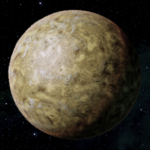System Specs:
- Stellar Mass: 1.7 Sol Masses
- Stellar Class: A
- Luminosity: >8 Sol
- Planets: 5
- Moons: 1
- Asteroid Belts: 1
- Asteroids: 1
- Objects: 0

–
Planets Directory:
- Jontan
- Euntanta
- asteroid belt
- Beyalt
- Doriae
- Tarith
- Xetic
–
Jontan:

- Orbital Distance: 0.2 AU
- Orbital Period: 25 Earth-days
- Keplerian Ratio: _ 17.863
- Radius: 67,428 km
- Day Length: 25 Earth-hours
- Atmospheric Pressure: N/A atm
- Surface Temp: N/A °C
- Surface Gravity: N/A g
- Mass: N/A Earth-masses
Jontan is a fairly standard close-orbiting “Pegasid” gas giant, orbiting the star Lusarn at high velocity and heated to temperatures of over 1,000 degrees. Analysis of its orbit has revealed a core of heavy elements with a mass double that of the planet’s hydrogen-helium atmosphere.
–
Euntanta:

- Orbital Distance: 1.04 AU
- Orbital Period: 0.3 Earth-years
- Keplerian Ratio: 12.498
- Radius: 7,740 km
- Day Length: 24.2 Earth-hours
- Atmospheric Pressure: 0.98 atm
- Surface Temp: 415 °C
- Surface Gravity: 1.0 g
- Mass: 1.462 Earth-masses
- Colony: population 230
Euntanta is remarkably close to Earth. Its orbital distance is similar, and while slightly larger, its reduced density yields similar mass, atmospheric pressure, and gravity. There the similarities end, for Lusarn is a hot class F star, emitting over eight times the energy of Sol. Euntanta is a parched wasteland, its water long since boiled away into its nitrogen-carbon dioxide atmosphere.
A handful of mining outposts dot the hellishly hot surface. The crews remain in underground bunkers, sending remotely controlled machines out at night to do surface work and load cargo for shipment.
–
Beyalt:

- Orbital Distance: 1.54 km
- Orbital Period: 1.47 Earth-days
- Keplerian Ratio: N/A
- Radius: 222 km
- Day Length: 28.8 Earth-hours
- Atmospheric Pressure: Trace atm
- Surface Temp: 173 °C
- Surface Gravity: 0.001 g
- Mass: 0 Earth-masses
Lusarn’s heat pummels the Nirana Belt, a ring of protoplanetary material relatively close to the star. However, this heat is not enough to instigate true melting as occurs in a planet’s formation, so carbonaceous asteroids such as Beyalt retain a primitive makeup. Beyalt has yet to be exploited, so the Reapers appear to have ignored it. Probes suggest it is high in chondrites and troilite.
–
Doriae:

- Orbital Distance: 2.48 AU
- Orbital Period: 3.0 Earth-years
- Keplerian Ratio: 1.695
- Radius: 8,700 km
- Day Length: 63 Earth-hours
- Atmospheric Pressure: 1.17 atm
- Surface Temp: 204 °C
- Surface Gravity: 1.2 g
- Mass: 2.216 Earth-masses
Doriae is a large, hot world with a poisonous atmosphere of acidic nitrogen oxides. While the planet is too close to Lusarn for this to condense and fall as rain, this makes the environment too hostile for forms of life more sophisticated than bacteria to evolve.
–
Tarith:

- Orbital Distance: 7.8 AU
- Orbital Period: 16.7 Earth-years
- Keplerian Ratio: 1.702
- Radius: 5,677 km
- Day Length: 27.7 Earth-hours
- Atmospheric Pressure: 0.84 atm
- Surface Temp: 21 °C
- Surface Gravity: 0.87 g
- Mass: 0.684 Earth-masses
Tarith is broadly Earth-like, with a fatal flaw; it has a relatively high amount of chlorine in its atmosphere, the reason for the greenish haze that becomes apparent when looking at the horizon. Chlorine has become a vital component in Tarith’s [sic] plant life; as a defense mechanism against native herbivores, many species evolved the ability to release clouds of toxic chlorine when disturbed. This gas is heavier than the atmospheric oxygen, and tends to settle in low places. While avoidable, this has placed Tarith near the bottom of the lists for colonization.
–
Xetic:

- Orbital Distance: 15.6 AU
- Orbital Period: 47.4 Earth-years
- Keplerian Ratio: 1.69
- Radius: 30,054 km
- Day Length: 13.7 Earth-hours
- Atmospheric Pressure: N/A atm
- Surface Temp: N/A °C
- Surface Gravity: N/A g
- Mass: N/A Earth-masses
- Satellites: 1
A common methane-ammonia gas giant, Xetic is best known for the infamous Kal’thor Camp. Established on the ice moon of Gesis, Kal’thor was a Blue Suns hostile environment training facility, run by a cadre of former batarian Special Intervention Unit operators. In 2168, a cluster-wide scandal broke out when it was revealed that the mortality rate of recruits sent to the camp might be as high as 18%.
Investigation by asari authorities based on Illium uncovered group graves around the facility containing the remains of several hundred recruits, dating back two decades. The camp was immediately closed, and the remains sent back to their worlds of origin. An inquest by the Blue Suns found the batarian commandos had used harsh training methods, but these were consistent with their own training to join the SIU. The batarians were exonerated, though Kal’thor was shut down, and they were reassigned to other units. As the Crescent Nebula is beyond the sphere of Council law, no civil charges could be filed against the Blue Suns.
–
–
video







